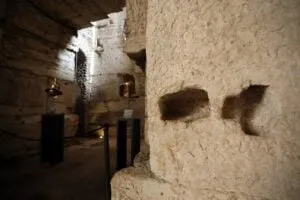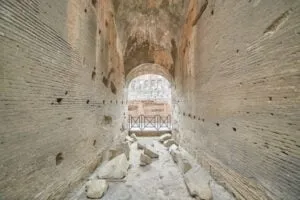The Roman Colosseum, a magnificent symbol of the Roman Empire, still stands proudly after nearly 2000 years of history. Every year, over 6 million tourists flock here to admire its majestic architecture and discover the mysterious stories behind the bloody battles. Are you ready for a journey to explore this ancient arena?
Explore the Roman Colosseum: History, Visiting Tips, and What to Know
Join “Du lịch khắp thế gian” (Travel the World) to explore the Colosseum, from its history of formation and unique architecture to useful visiting tips to help you have the most complete experience. Don’t miss the opportunity to immerse yourself in the space of heroic history and feel the awe before this great architectural work!
About the Roman Colosseum
The Roman Colosseum, also known as the Colosseum, is one of the greatest architectural works remaining from the Roman Empire. Built around 70-80 AD during the reign of Emperor Vespasian, the Colosseum was once the venue for gladiatorial combats, public performances, and many other events. With a capacity of up to 50,000 people, the Colosseum is a symbol of the power and authority of ancient Rome.
History of the Colosseum’s Formation
The construction of the Colosseum began around 70-72 AD, during the reign of Emperor Vespasian of the Flavian dynasty. The arena was built on land that was previously an artificial lake belonging to the Domus Aurea complex built by Emperor Nero. The purpose of building the Colosseum was to give the people of Rome a magnificent entertainment venue, while restoring stability after a period of civil war. The project was completed in 80 AD during the reign of Emperor Titus, Vespasian’s son.
Unique Architecture of the Colosseum
The Colosseum is an elliptical amphitheater with a major axis length of 189 meters, a minor axis length of 156 meters, and a height of 48 meters. The structure is built mainly of travertine stone, brick, and concrete. The Colosseum has four floors, of which the lower three floors have arches decorated with columns in the classical Greek architectural style. The top floor has small windows and pilasters.
Inside the Colosseum is a central elliptical arena, where the battles took place. The arena floor was made of wood and covered with sand. Beneath the arena floor is a system of tunnels and rooms, where gladiators and animals were held before they were brought into the arena.

The Colosseum was designed with a complex drainage system, allowing water to be quickly drained from the arena after heavy rain. The arena also had a canvas awning system, helping to protect the audience from the sun and rain.
Colosseum Visitor Guide
To have a complete and memorable visit to the Colosseum, you should note the following:
Ideal Visiting Time
The best time to visit the Colosseum is in spring (April-May) or autumn (September-October). At this time, the weather in Rome is quite pleasant, not too hot and not too cold, and the number of tourists is not too crowded.
If you come to Rome in the summer (June-August), try to get to the Colosseum in the early morning (around 8:30 am) or late afternoon (about an hour before closing) to avoid crowds and the intense heat.
Buying Tickets
You can buy Colosseum tickets online on the official Colosseum website or at the ticket office. However, to avoid having to wait in long lines, you should buy tickets online before arriving. There are many types of tickets for you to choose from, including regular admission tickets, priority tickets, and underground area tickets.
If you want to learn more about the history and architecture of the Colosseum, you should join a guided tour. These tours usually last about 1-3 hours and are led by professional guides who are knowledgeable about the Colosseum.

Important Notes When Visiting
- Wear comfortable shoes: You will have to walk a lot during your visit to the Colosseum, so wear comfortable shoes to avoid foot pain.
- Stay hydrated: Especially in the summer, remember to drink enough water to avoid dehydration.
- Wear a hat and sunscreen: To protect your skin from the intense sun, wear a hat and sunscreen.
- Be aware of pickpockets: As in any major city, you should be aware of pickpockets when visiting the Colosseum.
- Respect historical sites: Do not climb on the walls or touch artifacts in the Colosseum.
Explore the Underground Area of the Colosseum
One of the most interesting experiences when visiting the Colosseum is exploring the underground area. This area was once where gladiators and animals were held before they were brought into the arena. Today, you can visit this area through special tours.
Joining a tour to visit the underground area, you will have the opportunity to learn about the lives of gladiators, how they were trained and prepared for battles. You will also admire the system of tunnels and rooms, where secret and brutal activities once took place.

Combine Visiting Nearby Attractions
The Colosseum entrance ticket also includes admission to Palatine Hill and the Roman Forum, two other important historical sites in Rome. Palatine Hill is one of the seven hills of Rome, believed to be where Romulus and Remus, the founders of Rome, were raised by a she-wolf. The Roman Forum was once the political, religious, and commercial center of ancient Rome.
After visiting the Colosseum, you can walk to Palatine Hill and the Roman Forum to explore more about the history and culture of Rome.
Tips for Saving Money Visiting the Colosseum
- Visit on the first Sunday of the month: On the first Sunday of each month, visitors can visit the Colosseum for free. However, you need to prepare to face large crowds.
- Buy a Roma Pass: If you plan to visit many places in Rome, you can buy a Roma Pass, a card that allows you to enter free or discounted at many museums and historical sites.
- Bring your own food and drinks: To save on food costs, you can bring your own food and drinks from outside into the Colosseum.
Conclusion
Visiting the Roman Colosseum is an unmissable experience when coming to Rome. With its long history, unique architecture, and fascinating stories, the Colosseum is sure to leave you with unforgettable impressions. Hope these guides and visiting tips will help you have a complete and memorable trip. Don’t forget to share your experiences with “Du lịch khắp thế gian” (Travel the World)!